ISSN: 1204-5357
ISSN: 1204-5357
| AZLEEN ILIAS, MBA Senior Lecturer, Universiti Tenaga Nasional (UNITEN), Malaysia. Postal Address: Department of Accounting-College of Business and Administration UNITEN-Campus Sultan Haji Ahmad Shah, 26700, Muadzam Shah, Pahang Malaysia. Author′s Personal/Organizational Website: http://www.uniten.edu.my/newhome/uploaded/staff_profiles/coba/accounting/Azle en%20Ilias.pdf Email: azleens@uniten.edu.my / azleenilias@yahoo.com Azleen Ilias is a member of Department of Accounting. Her research is focused on Services in Extensible Business Reporting Language (XBRL), Computerised Accounting System, Public Sector Accounting, Reporting Technology, Financial and Management Accounting Practice and Business Reporting and Public Sector Accounting. To date, she has published her research in academic journals such as Computer Information Systems (CIS) and International Business Research (IBR), the Journal of Internet Banking and Commerce, IPN Journal of Research and Practice in Public sector Accounting and Management, Review of Integrative Business & Economics Research and Sustaining Competitiveness in a Liberalised Economy: the Role of Accounting |
| MOHD ZULKEFLEE ABD RAZAK, MBA |
| Senior Lecturer, Department of Marketing and Entrepreneur Development, College of Business and Accounting, Universiti Tenaga Nasional. Postal Address: Department of Marketing and Entrepreneur Development, College of Business and Accounting, Universiti Tenaga Nasional, Sultan Haji Ahmad Shah Campus, 26700, Bandar Muadzam Shah, Pahang, Malaysia Author′s Personal/Organizational Website: http://www.uniten.edu.my/newhome/content_list.asp?contentid=3414 Email: zulkeflee@uniten.edu.my Mohd Zulkeflee Abd Razak research interests include Services Marketing, Retailing, International Business and Cross-cultural Issues, Accounting, Banking and Financial Instrument-based Services. To date, he has presented and published his research at national and international conferences and in journals such as Computer Information Systems (CIS) and International Business Research (IBR), the Journal of Internet Banking and Commerce, IPN Journal of Research and Practice in Public sector Accounting and Management, Review of Integrative Business & Economics Research and Sustaining Competitiveness in a Liberalised Economy: the Role of Accounting. |
| SITI FARA FADILA ABD RAZAK, MBA |
| Lecturer, Department of Finance and Economics, College of Business and Accounting, Universiti Tenaga Nasional. Postal Address: Department of Finance and Economics, College of Business and Accounting, Universiti Tenaga Nasional, Sultan Haji Ahmad Shah Campus, 26700, Bandar Muadzam Shah, Pahang, Malaysia Author′s Personal/Organizational Website: http://www.uniten.edu.my/newhome/uploaded/staff_profiles/coba/finance%20and %20economics/Siti%20Fara%20Fadila%20Abd%20Razak.pdf Email: sitifara@uniten.edu.my Her research interest are Corporate Governance, Mutual Funds, Islamic Wealth Management, Security Analysis, Contemporary Issues in Finance, Volatility of Gold, Government / Public Agencies, Education, Accounting Based Services, Banking Based Services & Financial Instrument Based Services. |
Visit for more related articles at Journal of Internet Banking and Commerce
The current study had explored the Extensible Business Reporting Language (XBRL) among various stakeholders from a financial reporting perspective. In addition, the impact of the benefits on users, organization and preparers might vary according to the culture, country or financial regulations. Thus, this research will focus on Malaysia since Malaysia is multi-cultural and the adoption of XBRL can be considered as a new development. Pertaining to this research, it is important to understand the concept of a new reporting technology and the way XBRL will provide interactive data. The awareness and intention to adopt the XBRL will resume effectively once users, preparers and regulators are able to understand the whole concept of XBRL. This research is considered significant in order to explore the readiness and awareness of new reporting technology in Asia, particularly in Malaysia. This study found only a few respondents was fully aware of XBRL, while the majority of respondents were unaware about XBRL. Besides awareness, the study found that there are approximately 67.2% of respondents who are likely to investigate the XBRL technology, which indicates that there is a possibility that XBRL will be more significant and eventually accepted by stakeholders. This study found that approximately 3.1% understood fully what XBRL is and 18% understood the basic concepts.
Keywords |
| Extensible Business Reporting Language, XBRL, financial reporting, technology, Malaysia, awareness, adoption, stakeholders |
INTRODUCTION |
| The financial and non-financial information is usually distributed and disseminated by digital reporting formats. The well-known digital reporting formats are the Portable Document Formats (PDFs) and Hypertext Mark-up Language (HTML), which are exactly the same as the printed version. Currently, there is a new development in reporting format technology, which is known as eXtensible Business Reporting Language (XBRL). XBRL is an advanced technology and an extension to communicate corporate reporting in a structured manner in order to be understood and received across borders. The XBRL is a more effective reporting technology format compared to PDF and HTML. Cox (2006) from the U.S. Securities and Exchange Commission had agreed that the interactive data would be provided by a new reporting technology, which has the capability of real-time reporting and real-time analysis. |
| Lymer, Debreceny, Gray & Rahman’s (1999) report showed the development and evolution of business reporting. The existing technology had started business reporting with printed financial statements and CD-ROMs. Then came the electronic paper version, whereby the annual report was distributed through the internet. The electronic version is exactly the same as the paper based printed financial report. The well-known electronic version is the Adobe Acrobat software, which can be read by the Acrobat Reader. Besides that, other electronic versions that are used are Microsoft Word and the Excel Spreadsheet. According to Xiao, Jones & Lymer (2005), experts believed that internet reporting would be the norm and companies would place all financial reporting on the web. |
| Next, there is the Hypertext Mark-Up Language (HTML) technology, which is used to support navigation and links between pages. HTML focuses more on presentation and graphics, thus the development of “plug-ins” function to improve the efficiency of web sites. Some examples of “plug-ins” are Flash, Macromedia’s Shockwave and Adobe Acrobat. Then, in order to ensure that information such as profit announcements, analyst briefing and dissemination of annual meetings in real-time, there is interactive multimedia in the web sites. The interactive multimedia that has been set-up in the website is RealPlayer and Quicktime. Besides all the technology, the technology experts have come up with 3D reporting, connection between web pages and database, providing search engine tools, designing websites with a variety of interactions on the pages by using Java applets in simple spreadsheets, statistical data, graphs, and display charts related to accounting information. |
| There is also a push technology, which collects emails from stakeholders or users that need updated information from reports and processes them. Then, there is the intelligent agent that complements human analyses and provides further support, particularly for decision makers, such as analytical tools, for quick ratios in the websites. After the existence of HTML, the eXtensible Markup Language (XML) was developed to facilitate the exchange of information on the internet. The latest technology in business reporting is the eXtensible Business Reporting Language (XBRL), which came into existence when Charles Hoffman found that XML had capabilities for electronic reporting. The implementation of XBRL can be seen as a worldwide adoption since XBRL has been implemented, for instance in UK, US, Netherland, Australia, Singapore, Japan, India and China. |
| The eXtensible Business Reporting Language (XBRL) |
| Charles Hoffman is the founder of XBRL and started it in 1998. He has been called ‘the father of digital language of business’. Extensible Business Reporting Language (XBRL) is a global standard for business reporting. Charles Hoffman had started the XBRL after he found that the eXtensible Markup Language (XML) could be used for presenting financial statements and auditing purposes. During that time, the AICPA (American Institute of Certified Public Accountants) was the key organization for developing the XBRL international standard, particularly for business reporting (Hoffman, 2006). Based on XBRL, the International standards have been described as: |
| “XBRL is the extension of XML language that is used to communicate tagged data on the internet. XBRL stands for eXtensible Business Reporting Language. It is a language for electronic communication of business information, providing major benefits in the preparation, analysis and communication of business information. It offers savings in costs, greater efficiency and improved accuracy and reliability to all those involved in supplying or using business information. An international non-profit consortium of over 600 major companies, organisations and government agencies is developing XBRL, which is an open standard and free of license fees. It is already being put to practical use in a number of countries and implementations of XBRL are growing rapidly around the world.” (http://www.xbrl.org). |
| XBRL can be difficult to understand because it seems similar to a technical sound and based on Bergeron (2003), XBRL can be defined from a business perspective as: “an open independent platform, international standard for a timely, accurate, efficient and cost effective electronic storage, manipulative, repurposing, and communication of financial and business reporting data. XBRL is fundamentally about a standard language for reporting financial data”. |
| Based on Bergeron (2003), XBRL is an extension of Extensible Markup Language (XML), which is a language that has been extended to business reporting standards. XBRL exists because of the challenge in reporting, since there few problems in reporting based on electronic data interchange (EDI). Electronic reporting was developed to overcome the disadvantages of communicating corporate information in the paper-based version, which ensures a lower cost of communication and transaction. However, there are also challenges of using the electronic data interchange (EDI) since there are several standards involved in exchanging electronic documents and EDI systems used by companies that are not compatible with each other. Thus, the challenges of EDI have been resolved by the existence of the internet and the use of static web pages via Hypertext Mark-up Language (HTML) to transmit and distribute general communications, email and e-commerce. Since HTML is a static web page that is difficult to share transactions and reports in real-time, several languages were developed such as Extensible Mark-up Language (XML). XML is a language compatible with the internet and for communications. Bergeron (2003) also mentioned that XML is known to be extensible or easily modified and the language is able to provide extended vocabulary for text and images in all fields and areas. XML owns unique characteristics that enable corporate information to be translated, transmitted and communicated between different systems. Since XML is an attractive and freely available language, the new evolutions and extensions from XML have been developed and is known as eXtensible Business Reporting Language (XBRL). |
| A standards committee established XBRL vocabulary while XML is a language with a standard mode for referring and reporting all business transactions. |
| Reports using the XBRL will be comprehensive compared to HTML, which is in plain text. XBRL is extensible and more specific then XML, which makes data more identifiable by the system. In XBRL, the amount will be very comprehensive whenever the numbers have been tagged by taxonomy or vocabulary that has been communicated via several systems. For example, it as useful as a bar code on a product that is scanned during payment, such as <Product series>1234562342</Product Series>. The numbers attached to the products will appear meaningful and indicate the product category. For example, to report the amount of “Dollars 20,000 for Account Receivable” with Microsoft Excel, the amount will appear as plain text. However, reports in XBRL are different because the tag or taxonomy will be attached with the amount of Dollars 20,000. It will be tagged and appear as: <Account Receivable currency=”Dollars>20,000</Account Receivable>. |
| XBRL will make the life of business documents, reports and exchanges easier and effective when the data becomes more meaningful. The report can be utilized and used by every stakeholder and organization from various countries although under different jurisdictions, regulations and accounting standards. With one single information supply chain, organizations only need to create one report for every user instead of different reports for different users. |
| In this study, researchers will discuss the awareness of users and preparers on the benefits of using XBRL standard formats based on other previous researchers and adopters. The concept of benefits needs to be understood in order for awareness, adoption and acceptance of XBRL by organizations and users. Cox (2006) in a speech had mentioned, “far too many people think XBRL might be a new car model or maybe a newly discovered medical condition”. The statement indicates that there are some challenges for users and preparers in understanding the implementation and implication of XBRL. Thus, the government needs to educate users on the concept of XBRL and how future adopters will benefit by its implementation. The full understanding of the concepts will improve the level of awareness of all parties involved in formulating future digital reports. The first challenge faced by every country pertains to awareness. In the U.S, as mentioned by Cox (2006), more than 10,000 public companies were not aware of the possibilities of XBRL. The awareness of the possibilities might be developed by improving the general knowledge of users on XBRL. As mentioned by Hoffman in a conversation with Tie (2005), he stated that the lack of general knowledge on XBRL is an important challenge faced by certified public accountants. |
| Besides awareness and understanding of benefits, the important terminology needs to be introduced to potential users or adopters. The understanding of the terminology and jargons will ensure that it is easier to understand the way XBRL works on reporting. In this study, a few important jargons will be highlighted based on experts such as Hoffman (2006), Bergeron (2003) and XBRL International. |
| Firstly, the meaning of the word ‘concept’, also known as the “financial reporting concept, has been defined in an XBRL taxonomy as an XML Schema element” |
| Second, the meaning of Context, which is known as “important information about the values” |
| Third, the meaning of XBRL Specification is known as “the XBRL syntax or technical rules” |
| Fourth, the meaning of XBRL Taxonomies is known as “concepts that are expressed within a dictionary” |
| Fifth, the meaning of XBRL Instant Documents is known as “business reporting in a special way and published in a special format” |
| In this research, it is important to understand the concept of a new reporting technology and the way XBRL will provide an interactive data. The awareness and intention to adopt the XBRL will be resumed effectively once users, preparers and regulators are able to understand the whole concept of XBRL. This research is considered significant in order to explore the readiness and awareness of new reporting technology in Asia, particularly in Malaysia. The readiness of stakeholders can be substantiated by understanding the concepts and benefits of XBRL. Since XBRL is still new in Malaysia, more research needs to be done on the user’s present and potential awareness, understanding and interest in XBRL. In addition, research also needs to be done on future impact of XBRL adoption among various stakeholders. As mentioned by Francis (2012), XBRL can be very useful to accountants, auditors, chief executive officer, chief finance officer, investors, financial advisors and regulators. Thus, this current study will explore the adoption of XBRL among various stakeholders. Furthermore, the impact of the benefits on users, organization and preparers might be different according to the various cultures, countries or financial regulations. Thus, this current research will be valuable in the Malaysian context since Malaysia is multicultural. As mentioned by Liu (2013), different cultural and financial regulatory factors will influence the decision to adopt XBRL. Thus, the currents authors believe that their study will discover exploratory results in order to ensure the adoption of XBRL in the future. |
LITERATURE REVIEW |
| The Awareness of the eXtensible Business Reporting Language (XBRL) |
| The adoption of XBRL by the stakeholders will be even more challenging if they did not understand or are unaware of the concepts and benefits provided by implementing XBRL. Most researches had found a low level of awareness at the early stage of XBRL introduction. |
| Pinsker (2003) did a study in the US on seven auditors and nine accountants on the knowledge, experience and perceived benefits pertaining to XBRL. The study found a low level of knowledge (1.71) and experience (1.24) concerning XBRL and they had expected the low level of experience by the users because of the new XBRL software. These results were based on the seven-tier Likert scale from 1 being “low” and 7 being “high”. The research concluded that XBRL International needed to communicate the understanding, knowledge and usage benefits to a variety of auditing non-members all over the world. Thus, these users will really understand the meaning of XBRL and the reason why XBRL is important to auditors and accountants all over the world. |
| In 2007, the Institute of Certified Financial Analyst (CFA) conducted a survey that focused on awareness and knowledge on XBRL (CFA, February 2008). From the total number of respondents (N=856), approximately 59% were unaware about XBRL, 32% were aware about XBRL but were not up-to-date with XBRL usage in financial reporting. Besides, there is evidence that few respondents (9%) were aware and had up-to-date knowledge on XBRL usage in financial reporting. Among the CFA members, the awareness element was the most prominent feature among them in the United States (46%) and the most unaware members came from Latin America (71%). |
| In 2009, another XBRL survey done by the Institute of Certified Financial Analysts (CFA) had indicated that there was an improvement in the level of awareness (CFA, November 2009). The results showed that approximately 55% of respondents were not aware of XBRL, 35% were aware of XBRL but not up-to-date with XBRL usage in financial reporting and an increasing number of respondents (11%) were aware and planned to use XBRL in financial reporting. In 2009, the level of awareness was significantly lower in the Asia Pacific region and was highest (52%) in the US. Recent research by CFA in 2011 had found that 53% of members were not aware, 38% were aware but were not up-to-date with the usage and 9% were aware and planned to use XBRL. They also found that the level of awareness was significantly lower among CFA charter holders (28%) then non-charter holders (43%) compared with more tenured chart holders (59%). By comparing occupations, academics had the highest awareness (66 percent), followed by credit analysts (54 %), portfolio managers (53 %), research analysts (47 %), investment banking analysts (36 %), and financial advisors (36 %) (CFA, December 2011). |
| Another research by Nel & Steenkamp (2008) in South Africa had limited the research to chartered accountants and focused on the elements of awareness and understanding of XBRL implementation. The research found that more than 50% (89%) of respondents had never heard of XBRL prior to this research or had heard of it but did not know what XBRL was all about. The research also explored whether respondents were interested in investigating XBRL after the survey and it was found that only 17% were not interested to investigate further, compared to 84% who were interested in investigating further on XBRL. |
| Dune, Helliar, Lymer & Mousa (2009) had done research in the UK on XBRL from the perspective of stakeholders such as accountants in UK listed companies, external auditors, tax practitioners, representatives of investment management and the analyst community. This research aimed to investigate the level of awareness and understanding of XBRL, explore the benefits and difficulties of the new technology and the implications for auditing and assurance. |
| This study looked into whether respondents were aware of the benefits of XBRL. They found that most of the accountants, tax practitioners and users were not aware of the benefits of XBRL and they choose to answer, “do not know”. Then, they investigated the obstacles to XBRL adoption and found that only auditors seemed to understand and had some knowledge on it and most respondents comprising accountants, tax practitioners and users answered, “do not know”. In XBRL, tagging documents are very important for its implementation and most respondents had answered, “do not know”. This indicates that most of them lacked the knowledge and did not know anything about the taxonomies. |
| Venkatesh & Armitage (2012) had investigated the awareness among accountants and auditors. They found that 7.7% of respondents were aware of XBRL, while 43.6% said they were aware but knew few details about XBRL. Moreover, 17.9% had possessed moderate levels of knowledge and 30.8% had indicated possessing a high level of knowledge in XBRL. The awareness and understanding of XBRL was related to training received by respondents, as the research found that 51.3% did not receive any training or below average training. In addition, 17.9% of respondents had received average training and 30.8% had received well above average training on XBRL. Besides, researchers also found that respondents did not have the skills, expertise or training in order to provide assurance on XBRL data. |
| Steenkamp & Nel (2012) did a study on the adoption of XBRL in South Africa, which focused on the level of awareness, factors influencing adoption of XBRL and the impact of economic conditions on the decision to adopt XBRL. Firstly, they looked into the awareness on XBRL and found that 49.3% stated that they did not know what actually XBRL was, 45% had a slight idea on XBRL and 5.7% had some knowledge on it. The level of awareness and knowledge on XBRL implementation might be influenced by the source of the information on XBRL that will appear to users and potential users. This study also showed that about 83.1% understood was XBRL was from reading articles and browsing the internet. |
| The Adoption of the eXtensible Business Reporting Language (XBRL) |
| In order to adopt XBRL as a continuous disclosure reporting technology, Pinsker (2007) had developed a theoretical framework, which is based on Li et.al.,’s (2004) IT model (Computer Mediated Communication Apprehension-neighbourhood effect) and Fichman’s (1992) IT adoption (applying Technology Acceptance Model and Absorptive Capacity). Pinsker (2007) had used the framework to develop seven propositions from the relevant theories, which consist of factors (level of computer mediated communication apprehension, perceived usefulness, attitude, absorptive capacity, level of education, perceived technological market leadership and external pressures) that affect the decision to adopt XBRL. |
| Thus, Pinsker (2008) had extended his research based on theoretical development from his previous work (Pinsker, 2007). The purpose of his research was to provide a better understanding of XBRL adoption intentions of mid-level managers in large U.S firms. Pinsker (2008) focused on managers who had little or no previous XBRL knowledge and included MBA students enrolled in the accounting course. The study found that the Technology Acceptance Model and Absorptive Capacity represented appropriate theories for research on XBRL adoption. The research found that XBRL was perceived to be useful in their jobs. However, favourable attitudes by decision makers did not have an influence on XBRL technology. For Absorptive Capacity, Pinsker (2008) had found that the convenience to learn is positively related to the decision to adopt XBRL. |
| Troshani & Doolin (2005) had carried out qualitative research on XBRL in Australia, which explored the driving factors and their inhibitions that affected technology adoption. This research data were collected through semi–structured interviews that involved eleven interviewees from large accounting firms, software developers and vendors, regulatory agencies, XBRL Australia Ltd and tertiary accounting educators. |
| The research was done in order to determine the driving factors and their inhibitions in the context of environmental, organizational and innovation factors. |
| In the environmental contexts, they found few issues from the interviewees. The first category was the local adoption strategy, which found that the lack of effectiveness, flexibility and responsiveness in the local adoption strategy. The second category referred to the limited local XBRL success stories. The local success on XBRL adoption will actually reveal the benefits experienced by adopters and this might be easier for decision makers to decide whether to adopt or not. The third category is the design of the accounting standards, where the priority lies with the International Accounting Standard (IAS). In XBRL adoption, the successful adoption of IAS is a prerequisite that facilitates the creation of Australia’s single taxonomy. In an organizational context, researchers found two important categories. Firstly, employees need to be educated on the basic understanding of the functionality and benefits of XBRL. They also need to be fluent in using the applications on XBRL. Secondly, interviewees had raised the issue of limited resources, which involved time, expertise and funding that was required for developmental efforts. The last context is innovation factors, which involved limited software tool support and the instability of the XBRL specification. Firstly, interviewees touched on the issue of limited software tools on XBRL, which were in dire need by potential adopters. Secondly, the interviewees were of the view that XBRL specifications need to be stable with no changes, in order to ensure the stability and smooth running of the software. |
| Doolin & Troshani (2007) had found the issues and factors on organizational adoption, which were in line with the Technology-Organization-Environment (TOE) model. They carried out exploratory research through qualitative evidence that was in line with the technology-organization environment model. |
| In their study, the first context involved was technology. Based on relative advantage, they found that XBRL was beneficial to software vendors and professional accounting firms. |
| Complexity was the second context the researchers had found. Researchers found that specialized tasks and knowledge were required in order to develop specific taxonomies and tagging of financial data. |
| Thirdly, researchers had found trialability, which is one way to reduce uncertainty when trying out a new application. Potential adopters have the ability to observe and experience the benefits of XBRL, which can be a factor in XBRL adoption. Observability means that potential adopters will be interested in knowing about XBRL application and to determine whether XBRL is suitable according to the needs of the organization when they observe the readily available software. The last element that can influence the decision to adopt under the first context is stability. Here, potential adopters had mentioned about the stability of software tools and applications, especially the changes of specification and functionality. Another context is organization. They found that innovation and organizational readiness were able to influence the decision to adopt XBRL. The third context is environment. The first element in this context is market conditions, whereby market size will have an influence on XBRL. Second is the influence of trading partners. Researchers found that business partners were perceived to be part of a potential influence on organizations in relation to XBRL adoption. Third, the available information about XBRL and its benefits are crucial in increasing the awareness of new reporting technology in potential adopters. Active communication of information will attract potential adopter’s interest towards XBRL development. Fourth, researchers found that one of the reasons why there were limited XBRL adoptions in Australia was because of the lack of critical mass of XBRL applications, software tools and users. Interviewees claimed that software vendors were reluctant to invest time and resources into developing XBRL exporting facilities until there was a demand. The last element in the environment context is available support. The development of taxonomies depends on the accounting standards and format used. The taxonomies will change if the accounting standards keep changing. The development of XBRL must be in line with the harmonization of accounting standards. The study done by Doolin & Troshani (2007) was in line with Troshani & Rao (2007), in which Troshani & Rao (2007) had conducted convergent interviews and found that environmental, organizational and innovation related factors had an influence on XBRL adoption. |
| Nel & Steenkamp (2008) had also explored the future implementation and adoption of XBRL in organizations. They found that approximately 31% of the chartered accountants had perceived that their organization would implement XBRL in the coming future and 5% had perceived that their organization had already implemented XBRL. The study also looked into how accountants understood XBRL concepts and they found that 55% of overall respondents were actually aware and understood the basic concepts of XBRL, however 45% were aware but did not understand the basic concepts. |
| Pinsker & Li (2008) has done a study on XBRL adoption for financial reporting to look into the costs and benefits. Pinsker, Gara & Karim (2005) had mentioned in Pinsker & Li (2008) that due to a variety of information on business and financial reporting across countries worldwide, reporting had become more challenging, compared to traditional reporting that did not have a standard format and needed to be manually assembled from incompatible information systems in order to prepare a financial report. |
| Pinsker & Li (2008) had carried out interviews on four business managers from Canada, Germany, South Africa and the U.S pertaining to XBRL adoption. The purpose of the study was to improve the knowledge and understanding pertaining costs and benefits of XBRL adoption. The study found that the benefits accrued to XBRL adoption were the diversification of international corporate cultures, increased processing capability, reduced data redundancy, improved operation efficiency, reduced costs of bookkeeping, reduced time needed for generating financial statements, increased company efficiency due to lower operating costs, reduction in cost of adoption resulting from substantive technological capabilities and reduction in perceived risks of capital provision due to lower costs. Besides that, XBRL adoption is a key marketing tool used by companies to reach potential investors. In post adoption, respondents would view risks and costs as low and a reflection of them as being technically savvy early adopters. Besides, the study also mentioned that transparency in financial reporting increases the level of transparency in the organization. Finally, respondents believed that XBRL adoption would give companies the competitive advantage compared to non-adoption of XBRL technology. Pinsker & Li (2008) also emphasized that respondents had taken cognizance of the key emergence of financial reporting technology and expect to obtain the first mover advantage in the market. |
| Dune, Helliar, Lymer & Mousa (2009) had explored the regulations pertaining to adoption and the government’s involvement in XBRL implementation, which focused on five categories of reports such as financial reports, company’s house filing, non-financial reports, stock-exchange listing announcements and tax filing. Regarding financial reports, most of the respondents believed that the XBRL should be voluntary, with no government involvement; however, auditors preferred XBRL to be mandatory within 2 years. For company’s house filing, XBRL should be on a voluntary adoption basis and with no government involvement. In reference to non-financial reports, tax filing and stock exchange listing announcements, XBRL should be voluntary with no involvement of regulators or the government. |
| Dune, Helliar, Lymer & Mousa (2009) explored the requirement to have enough IT expertise or IT personnel if the organization wishes to adopt XBRL. The results showed that more than 50% did not agree that the organization needed to have IT expertise and knowledge. The study also investigated the respondents training experience on XBRL and found only four respondents had experienced in-house training and CPD requirements. Thus, training provided to stakeholders is relevant in improving their level of awareness, understanding and knowledge. |
| Bonson, Cortijo & Escobar (2009) did a research using the Delphi Technique to identify the factors that could affect companies that had volunteered to submit their information through XBRL. The study found three factors that played an important role in imparting an impact on voluntary adoption such as gaining deeper knowledge on XBRL, acquiring a company image as a pioneer in new technology adoption and the improvement of the firm’s reputation in the capital market. |
| Steenkamp & Nel (2012) had explored the factors influencing the adoption of XBRL. They found that the most common reason why their organization or clients did not implement XBRL was that XBRL was not yet mandatory (24.5%), followed by the reason that they did not perceive any benefits by implementation XBRL (18.6%). The study also found other reasons such as potential adopters not having the necessary technical knowledge (14.2%), management itself did not know what actually XBRL was (14.2%), respondents perceived that XBRL was not relevant to the organization (9.3%), the high cost involved in XBRL preparation prior to implementing XBRL (6.9%), respondents thought that management did not have the motivation or vision to adopt XBRL in their organization (2.9%), respondents believed that their current system was too old to adopt and implement XBRL (2.0%) and some believed the poor economic condition as one of the reasons (2.0%). |
| Steenkamp & Nel (2012) also discovered the level of perceived relevance of XBRL adoption in an organization. The study found that approximately 73.9% had perceived the adoption and implementation of XBRL as not relevant to their organization. The study concluded that preparers of financial reporting are supposed to believe that XBRL adoption is relevant to the organization because they are the people who are involved with financial information and XBRLs’ key focus is in that same area. Besides perceived relevance, the study investigated whether economic circumstances would influence the decision to adopt XBRL and found that a majority (87%) believed that economic circumstances would not have any impact in deciding whether to adopt XBRL in their organization. About 12% of respondents stated that XBRL implementation will be delayed or postponed due to economic circumstances and 1% felt that economic circumstances would part an impact on the decision on whether to adopt and implement XBRL. |
| Henderson, et.al., (2012) did a study on the adoption of XBRL with the purpose of investigating the driving force behind internal and inter-organizational XBRL adoption. This study was carried out based on the Technological-Organizational-Environmental (TOE) framework. Researchers had found that the factors for internal adoption were different compared to factors for inter-organizational XBRL adoption. This study carried out a survey comprising 65 organizations that had not adopted XBRL. The study found that relative advantage, compatibility, complexity and learning from external sources were factors that instigated the decision to adopt XBRL in an internal organization. However, learning from external sources and normative pressure had shown a significant effect in inter-organizational adoption. Thus, the study had concluded that relative advantage, compatibility and complexity had stronger influence on internal XBRL adoption compared in inter-organizations. |
| Most of the research had come out with a few factors that might influence XBRL adoption. Thus, it is important to ensure which factors that might significantly influence XBRL adoption. In a recent study by Liu (2013), the researchers had encouraged more research be carried out on the role of environmental factors pertaining to national cultures and financial regulatory environments in XBRL diffusion. The study had also motivated other researchers to carry out research on contingent factors such as organizational, cultural or financial regulatory factors that could influence value realization due to XBRL adoption. |
RESEARCH METHODOLOGY |
| Samples and Data Collection |
| Since XBRL was still in the beginning phase in Malaysia, it was difficult to obtain information on adoption and perception because at this phase the stakeholders had not experienced much on XBRL formats. Researchers began by contacting the relevant regulatory authorities involved in implementing XBRL in Malaysia for examining the early stages of XBRL adoption. In the beginning, researchers had done a short semistructured interview focusing on the relevance of implementing XBRL in Malaysia and the respondents were also required to provide feedback via a set of questionnaires. The researchers believed that all stakeholders were relevant and should be respondents in the research by providing feedback on the awareness, interest, understanding and adoption of XBRL. They were also asked to rate their understanding on XBRL concepts and benefits. |
| In order to use the method in this research, the researchers had called on all firms and relevant respondents involved in using and preparing business reports, especially in the Kuala Lumpur and Selangor area. The information on the firms was obtained from the representative of the Malaysian Institute of Accountants (MIA), Malaysian Yellow Pages and by approaching the attendees of MIA courses and conferences. The researchers found about 1200 potential respondents and eventually 650 potential respondents had agreed to provide some feedback. Thus, about 650 potential respondents were identified and had received a set of questionnaires; however, only 350 respondents from various job descriptions had successfully completed the questionnaires and returned them. Thus, the samples represented a response rate of approximately 58%. |
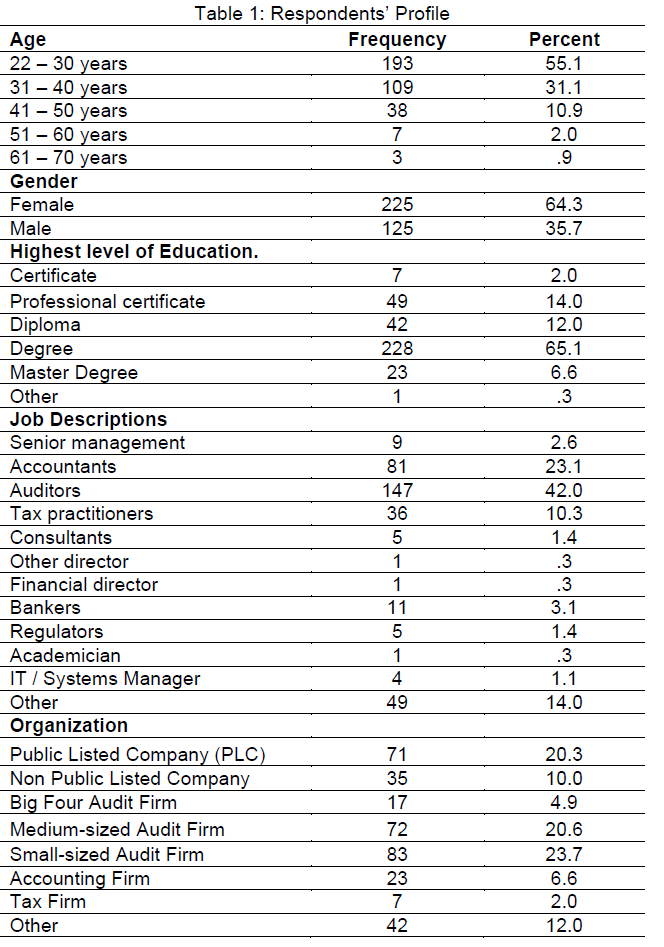 |
| In Pinsker’s study (2003), the respondents consisted of 17 internal auditors. Nel & Steenkamp (2008) had approximately 208 respondents from the overall number of chartered accountants in South Africa. In another research by Steenkamp & Nel (2012), some 337 chartered accountants were involved. Based on research done by the Institute of Certified Financial Analyst (CFA), it showed the lowest response rate of 9.03% from a total of 9,992 respondents in 2007 and 6.1% from a total 23,894 in 2009 (CFA, February 2008; November 2009). Henderson, et.al., (2012) had 65 respondents involved in their research from various job functions. Dune, Helliar, Lymer & Mousa (2009) had approximately 153 respondents from various groups involved. Whereas, for interviews done by Pinsker & Li (2008), the respondents involved were four representatives from four companies that had adopted XBRL. Troshani & Doolin (2005) had carried out semistructured interviews on 11 key representatives from organizational members of XBRL user-groups. |
| In addition, most of the previous research had used the qualitative and quantitative research methodology. As mentioned by Liu (2013), looking at the summary of XBRL research methods, about 65% of the research applied qualitative analysis, 20% used archival data analysis, 6% of interviews, 4% of case studies, 3% did experiments and 2% used the survey method. Thus, there were many researches done on XBRL using several methodologies in order to find significant and relevant results. |
| Instruments |
| The instrument for this research was divided into several parts that were pertinent to XBRL such as awareness, implementation, understanding, demand for XBRL knowledge and courses and intention to use. The questionnaire was developed through adoption and modification based on the suitability of the XBRL development in Malaysia. The items on this questionnaire were mainly developed based on Nel & Steenkamp (2008). Hence, for the purpose of ensuring sufficiency and suitability of the questions, the instruments were reviewed and pre-tested by researchers who were experts on XBRL and questionnaire survey. |
AWARENESS OF XBRL |
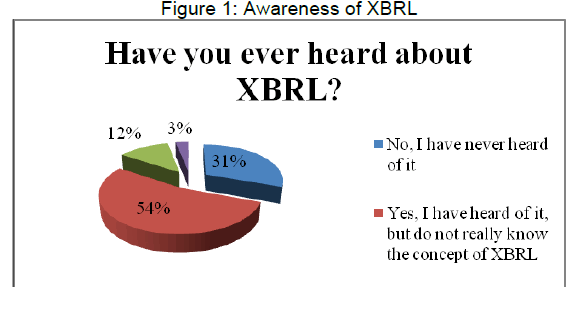 |
 |
| Generally, this result shows the awareness of XBRL in Malaysia. XBRL is still considered a new technology in Malaysia and its awareness might be relevant as an item to be identified in this study in order to determine the preparation process involved in shifting to a new technology. This study had found that 55 respondents were aware and understood XBRL, 188 (53.7%) respondents did not really understand the concept of XBRL and 107 (30.6%) respondents had never heard about XBRL. These results are surprising because previous research had also shown similar low-levels of awareness at the first stage of adoption (Nel & Steenkamp, 2008 & Dune, Helliar, Lymer & Mousa, 2009). |
| Awareness of XBRL among job descriptions |
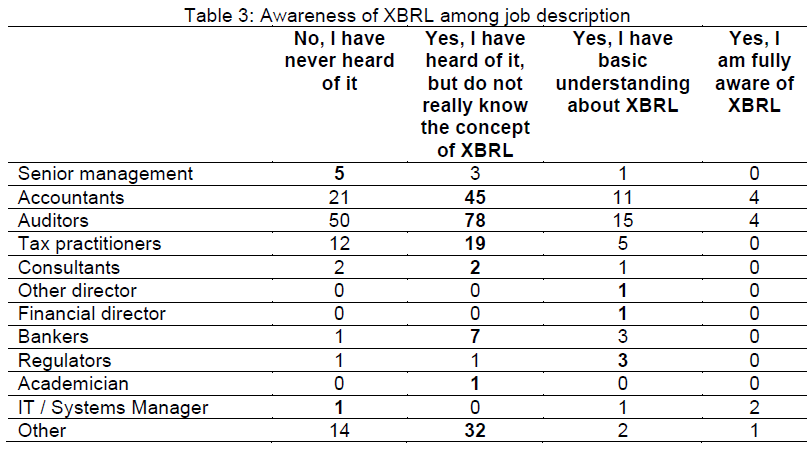 |
| This study had identified the level of awareness among respondents such as users in IFR and some of the preparers. Very few of accountants (n=4) and auditors (n=4) were aware and understood XBRL. Most of the accountants, auditors, tax practitioners, consultants, bankers and other job positions that were related with IFR had heard about XBRL but did not really know the XBRL concept prior to this survey. This result will help regulators to plan a lot of training and courses in order to introduce the benefits and emphasize the importance of implementing XBRL. |
| dXBRL is not only important for regulators but also for users and preparers of financial reports in order to improve the information supply chain. |
| Based on the research by CFA (February 2008), sell-side investment analyst had shown the greatest awareness in XBRL (51%), whereas fund and portfolio managers had shown the least awareness (5%) and indicated that most were unaware (63%) of XBRL. In another research by CFA (November 2009), academicians had shown the highest awareness level (72%) from total overall number of academicians. This was followed by research analyst (48%), portfolio managers (46%), financial advisors (45%), investment banking analysts (33%) and credit analysts (26%). |
Interest to investigate about XBRL |
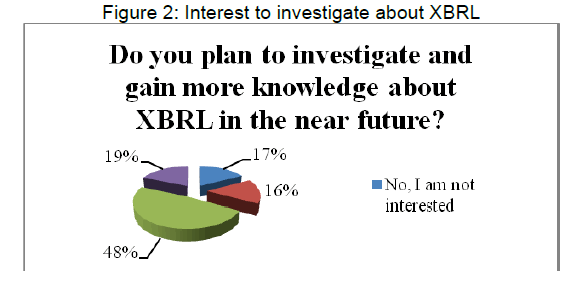 |
 |
| This study aimed to identify respondents’ interest to investigate and gain more knowledge on XBRL in the future, hence, 18.6% said they would investigate about XBRL and 48.6% said they would most likely investigate about XBRL. Fortunately, less than 50% said that they were not interested and XBRL was not relevant to them (32.8%). This is a signal to regulators to prepare more training and campaigning in order to attract new XBRL adopters. |
The Interest to Investigate about XBRL among Aware and Unaware Respondents |
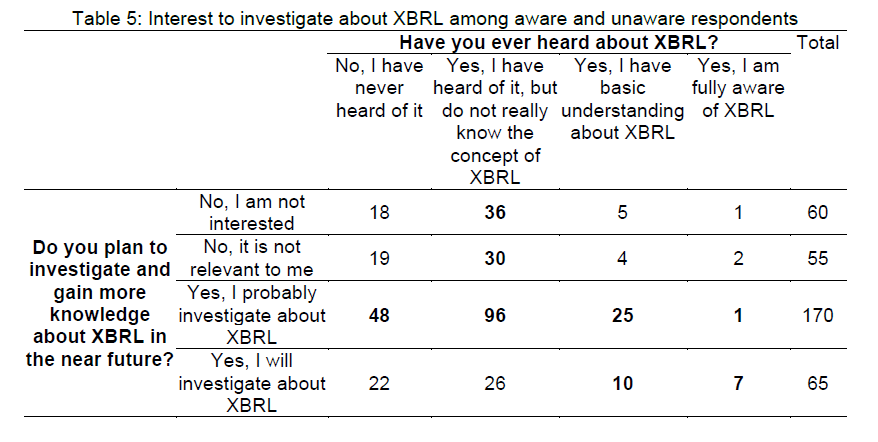 |
| This result shows whether respondents who are unaware about XBRL will or will not be interested to know more. The result indicated that 13.7% (n=48) of respondents who had never heard about XBRL were interested to investigate and understand more on the benefits, implementation and costs. About 18.8% (n=66) felt they were not interested and the issue was not relevant to initiate further investigation although they lacked the knowledge on the concept of XBRL. Fortunately, about 96 of the respondents had made efforts to know more about XBRL in order to understand the basic concepts. Besides that, it is also a good signal when there were about 43 respondents interested in enhancing their knowledge in the future even though they already had the basic knowledge on XBRL. |
| Implementation of XBRL at the organizational level |
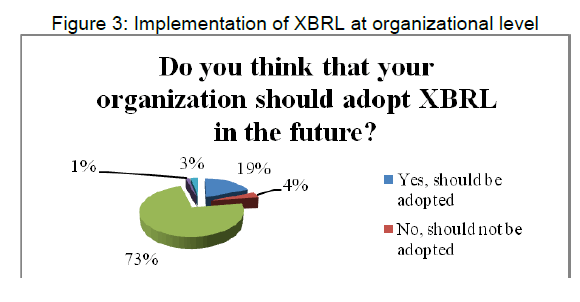 |
 |
| The results showed what respondents thought about the future implementation of XBRL in their organization. The majority of respondents responded with a “do not know” when asked if they thought whether their organization would or would not adopt XBRL. This decision might be influenced by their level of awareness that showed no basic knowledge on the concept of XBRL (85%). Only about 5 respondents indicated that XBRL was already implemented and 10 respondents indicated that their organization was in the process of preparing XBRL implementation. |
Understanding of XBRL |
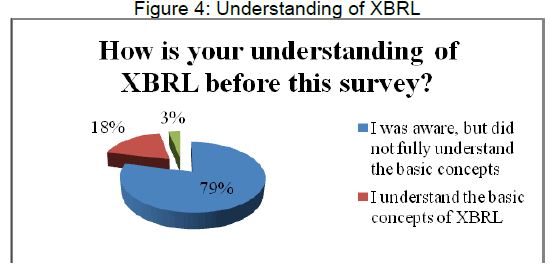 |
 |
| The study identified that 78.9% were aware but did not fully understand what XBRL was all about. This indicates that they were lacking the understanding of XBRL prior to this survey. Only 18% of respondents understood the basic concepts and 3.1% fully understood XBRL. The, researchers anticipated that the respondents might not be aware of this new reporting technology due to the lack of understanding of the basic concepts. |
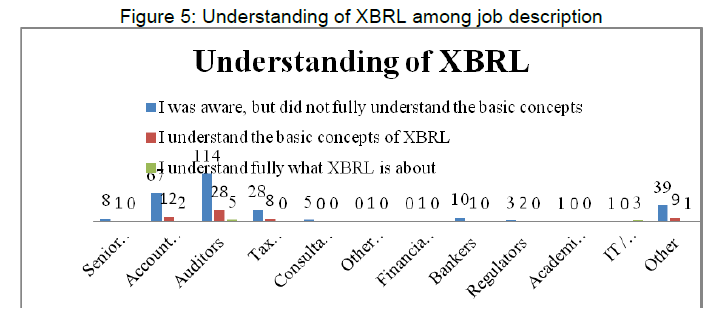 |
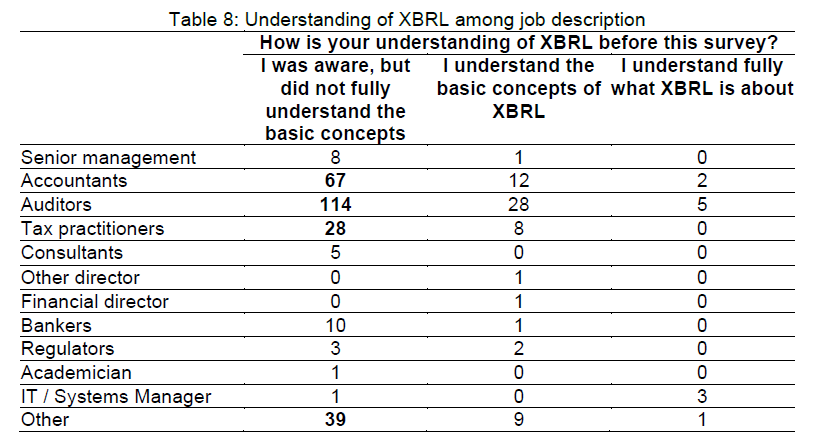 |
| This result shows the level of understanding according to the job description, which indicated that auditors (n= 114), accountants (n=67), tax practitioners (n=28) and other job positions (n=39) did not fully understand the basic concepts of XBRL. Normally, the XBRL concept will involve the concept of benefits, costs, implementations and any successful history of XBRL by early adopters. However, the results also showed a good indication whenever there were respondents who understood the basic concepts; in this case, the respondents were 33 auditors, 14 accountants, 8 tax practitioners and 10 with various job descriptions. This indicates that regulators were able to improve the level of awareness and understanding in order to ensure that the respondents will be part of future adopters. |
Demand for XBRL knowledge and courses |
 |
| Respondents were also asked about their experience in attending any course connected to XBRL. The results showed that only 9.4% of respondents had attended any course before this survey. Their experience from attending the course will improve their level of awareness and understanding pertaining to benefits, costs and implementation. |
 |
| Table 10 above shows that 33 respondents had attended some form of training in XBRL and the break-down shows that they had attended workshops (n=8), courses (4) and other types of training (n=11). This result suggests that regulators and enforcers should consider these respondents as new future adopters of XBRL. |
Intention to use XBRL in the future |
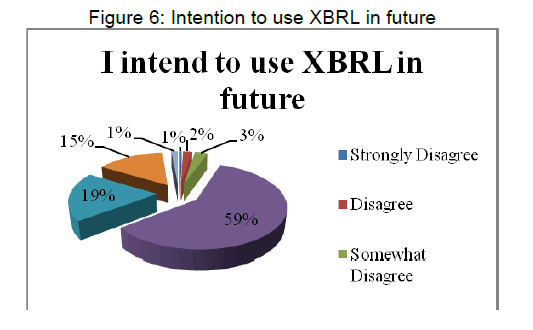 |
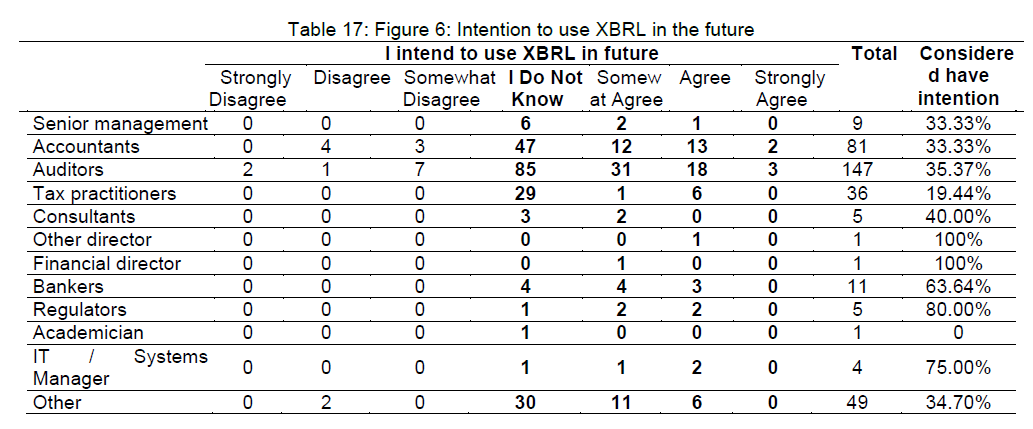 |
| The study investigated the respondents’ intention towards XBRL in the future according to their job position as preparers or users of financial reporting. The findings showed that 35.37% of auditors and 33.33% of accountants understood the concept and had the intention to use XBRL. Other potential users such as senior management, tax practitioners, consultants, other director, financial director, bankers, regulators, IT/Systems manager and other related users also had their own intention. However, accountants and auditors were a big portion since they were the biggest contributors in this research. |
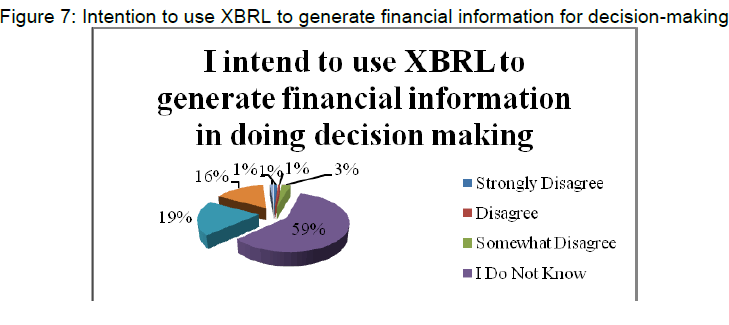 |
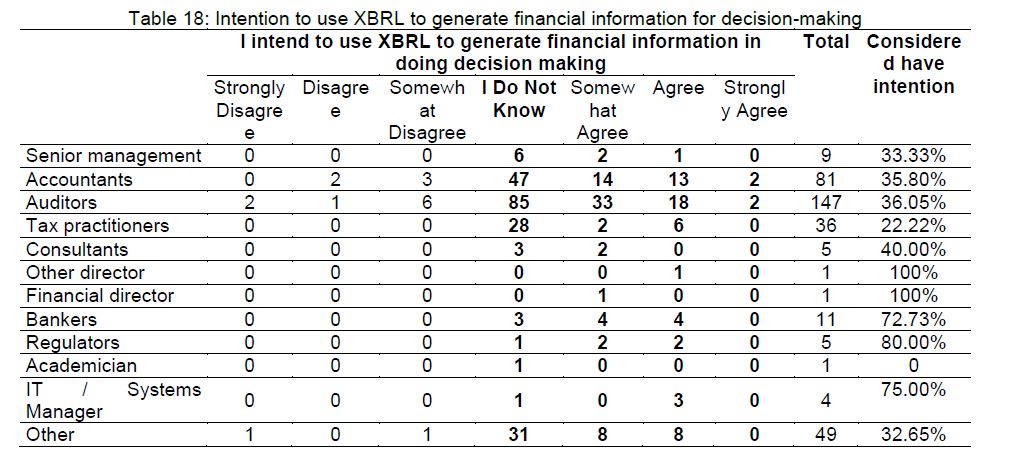 |
| One of the benefits for adoption and use of XBRL is for the purpose of making good business reporting and high quality decisions. A good business report would provide reliable information for decision-making and analysis for all preparers, users, regulators and related parties. From here, it can be seen that respondents that actually understood the concept of the advantages of XBRL for decision-making purposes would have the intention to use it in the future. |
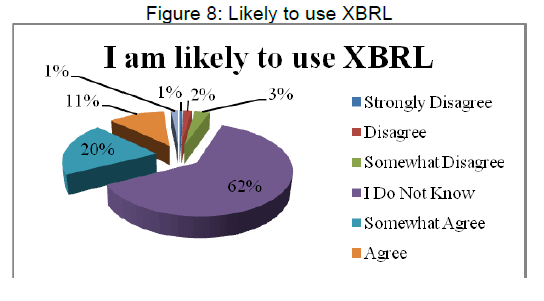 |
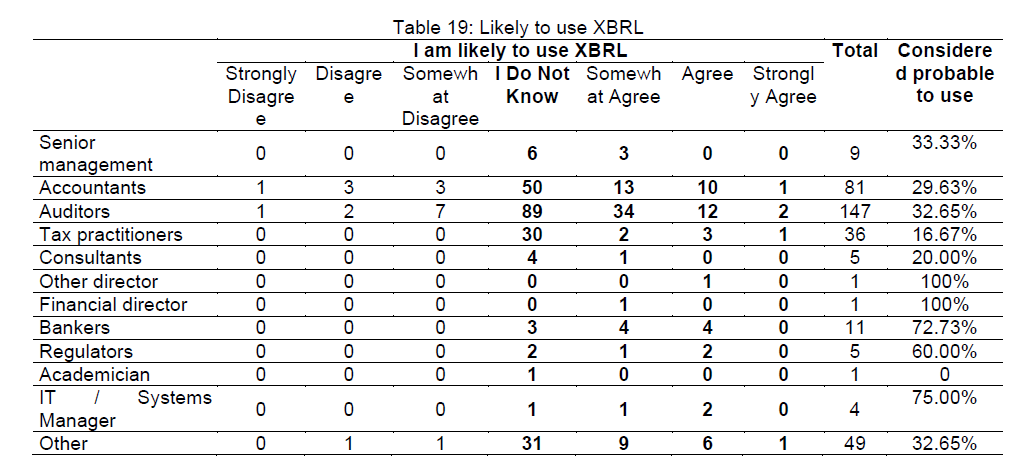 |
| This result shows that respondents would probably use XBRL technology in the future. It showed that more than 50% actually were not aware or understood the overall concept of advantages inherent in XBRL and this would lead to the respondents’ actually refusing to use the XBRL. Only 29.62% of accountants, 32.65% of auditors, 16.67% of tax practitioners, 33.33% of senior management, 20% of consultants, 72.73% of bankers, 60% of regulators, 75% of IT/System manager and 32.65% of other related jobs had the probability to use XBRL in the future. |
CONCLUSION AND DISCUSSION |
| XBRL is a new technology for communicating business reporting for the purpose of disseminating information to stakeholders. The XBRL is important not only to Information Technology personnel, but to accountants, external auditor, internal auditors, financial managers, analysts, regulators and every relevant party that is involved in preparing and using business reports. This study was considered an exploratory study as it discovered the beginning phase of XBRL in Malaysia by focusing on awareness, implementation of XBRL, understanding of XBRL, demand for XBRL knowledge and training courses, and intention to use. In Malaysia, XBRL is still in the beginning phase as Bank Negara Malaysia (Malaysia’s National Bank) introduced XBRL reporting to the financial industry in June 2012 and The Companies Commission of Malaysia (CCM) was in the stage of developing XBRL Taxonomy Elements for Financial Reporting, which was expected to be completed in 2014. The Companies Commission of Malaysia (CCM) believes that XBRL will provide more benefits in the future. |
| Moreover, this study had found few respondents who were fully aware of XBRL and a high percentage who were unaware of XBRL. This research is in tandem with Pinsker (2003) in the USA and the research done by the Institute of Certified Financial Analyst (CFA) in 2007 and 2009, Nel & Steenkamp (2008) in South Africa, Dune, Helliar, Lymer & Mousa (2009) in the UK, Venkatesh & Armitage (2012) and Steenkamp & Nel (2012). Based on survey done by Grant Thornton LLP (2006), about 46.30% of 381 senior finance executives were not aware of XBRL and the new standard for tagged business information. Another research done by Grant Thornton LLP (2007), found that approximately 59.70% of chief financial officers and senior controllers were not aware of XBRL. |
| Beside awareness, the study found that there were about 67.2% of respondents who were likely to investigate further about XBRL, which indicated that there was a possibility the XBRL would be more valuable and be accepted by stakeholders. Furthermore, about 192 of respondents (54.85%) did not know the concept of XBRL and would probably investigate further about XBRL. This result is in tandem with Nel & Steenkamp (2008). |
| The study also looked into whether respondents believed their organization would adopt XBRL in the future. Unfortunately, 72.9% perceived they did not know and did not have any idea pertaining to adoption and about 18.9% believed that their organization should adopt XBRL in the future. This result indicated that respondents would have ideas on the adoption if they were aware and understood everything about XBRL. The result from the current study had shown higher “do not know” than Nel & Steenkamp (2008). Based on Grant Thornton LLP (2006), about 52.45% of senior finance executives believed that XBRL would become a mandatory format that every organization would need to adopt. Compared with Grant Thornton LLP (2007), 50.75% of chief financial officers and senior controllers believed should be mandatory formats for SEC filings. |
| The current study questioned how respondents understood XBRL in relation to its concept and benefits. The findings showed that approximately 3.1% fully understood fully XBRL and 18% understood the basic concepts. Nel & Steenkamp (2008) found that 37% understood the basic concepts and 18% fully understood what XBRL is all about. Understanding was always related to the way respondents understood the benefits of XBRL. In 2007, Grant Thornton LLP had found that more respondents (2007: 13.43%, 2006: 8.60%) believed that the accounting industry had adequately communicated the benefits of XBRL concerning internal and external reporting. The early adopter’s understanding of the benefits were paramount in communicating it to potential stakeholders in order to develop their intention to adopt in the future. |
| Hence, in order to ensure their understanding of the benefits, the current research had posed the question regarding the courses attended prior to the XBRL survey. Not surprisingly only 9.4% had attended any related course on XBRL. This indicates that more courses and training related to XBRL should be held in the near future, particularly in Malaysia. Currently, CCM and MIA have initiated efforts by conducting a short course on XBRL in order to improve the awareness and understanding of the benefits of XBRL adoption. Nel & Steenkamp (2008) found that respondents believed that they needed to attend more courses. |
LIMITATIONS AND FUTURE RESEARCH |
| This current study had limitations whereby respondents were from various job descriptions from numerous parties involved in reporting instead of just focusing on each job description only. The small group of respondents in this study will not represent the whole issue of XBRL adoption in the future; however, it is still in accordance with other studies done since this study is a preliminary study of XBRL in Malaysia. It was very difficult to gain cooperation and feedback from respondents since XBRL was not really familiar to everyone. |
| In future, more research should be carried out by applying other research methodologies such as case studies and experimental studies and obtaining feedback regarding the initial process of the adoption. |
ACKNOWLEDGEMENT |
| I would like to express my heartfelt appreciation to Prof. Dr Noor Azizi Ismail (UUM) and Prof. Dr Ramayah (USM) for their invaluable and constructive suggestions during the planning and development of this research as part of their advisory. My special thanks is also extended to Universiti Tenaga Nasional for the grant provided for this research work. |
REFERENCES |
Bergeron, B. (2003), Essentials of XBRL: Financial Reporting in the 21st Century. Wiley. |
Copyright © 2025 Research and Reviews, All Rights Reserved